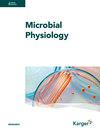Luciferase-Based Determination of ATP/NAD(H) Pools in a Marine (Environmental) Bacterium
IF 1.2
4区 生物学
Q2 BIOTECHNOLOGY & APPLIED MICROBIOLOGY
引用次数: 1
Abstract
In all living organisms, adenosine triphosphate (ATP) and NAD(H) represent universal molecular currencies for energy and redox state, respectively, and are thus widely applicable molecular proxies for an organism’s viability and activity. To this end, corresponding luciferase-based assays in combination with a microplate reader were established with the marine model bacterium Phaeobacter inhibens DSM 17395 (Escherichia coli K12 served as reference). Grey multiwell plates best balanced sensitivity and crosstalk, and optimal incubation times were 5 min and 30 min for the ATP and NAD(H) assay, respectively, together allowing limits of detection of 0.042, 0.470 and 0.710 nM for ATP, NAD+, and NADH, respectively. Quenching of bacterial cell samples involved Tris-EDTA-DTAB and bicarbonate base-DTAB for ATP and NAD(H) assays, respectively. The ATP and NAD(H) yields determined for P. inhibens DSM 17395 at ¼ ODmax were found to reside well within the range previously reported for E. coli and other bacteria, e.g., 3.28 µmol ATP (g cellsdry)−1. Thus, the here described methods for luciferase-based determination of ATP/NAD(H) pools open a promising approach to investigate energy and redox states in marine (environmental) bacteria.基于萤光素酶的海洋(环境)细菌ATP/NAD(H)库测定
在所有生物体中,三磷酸腺苷(ATP)和NAD(H)分别代表能量和氧化还原状态的通用分子货币,因此是生物体生存能力和活性的广泛适用的分子替代物。为此,用海洋模式细菌Phaeobacter inhibbens DSM 17395(作为参考的大肠杆菌K12)建立了相应的基于荧光素酶的测定法,并结合酶标仪。灰色多孔板对ATP和NAD(H)测定的灵敏度和串扰的最佳平衡以及最佳孵育时间分别为5分钟和30分钟,使ATP、NAD+和NADH的检测限分别为0.042、0.470和0.710nM。细菌细胞样品的猝灭分别涉及用于ATP和NAD(H)测定的Tris-EDTA DTAB和碳酸氢盐碱DTAB。在¼ODmax下,为P.inhibbens DSM 17395测定的ATP和NAD(H)产量被发现在先前报道的大肠杆菌和其他细菌的范围内,例如3.28µmol ATP(g cellsdry)−1。因此,本文所述的基于荧光素酶的ATP/NAD(H)池测定方法为研究海洋(环境)细菌的能量和氧化还原状态开辟了一种很有前途的方法。
本文章由计算机程序翻译,如有差异,请以英文原文为准。
求助全文
约1分钟内获得全文
求助全文

 求助内容:
求助内容: 应助结果提醒方式:
应助结果提醒方式:


